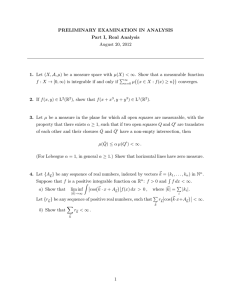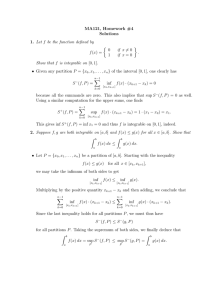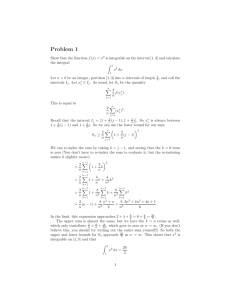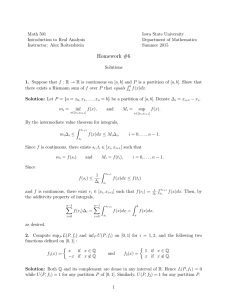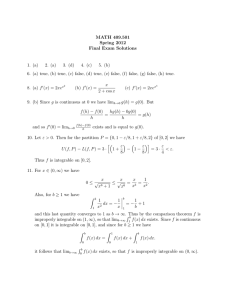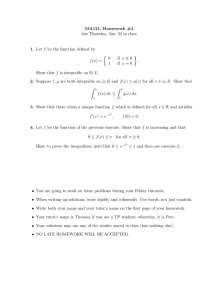Notes
advertisement
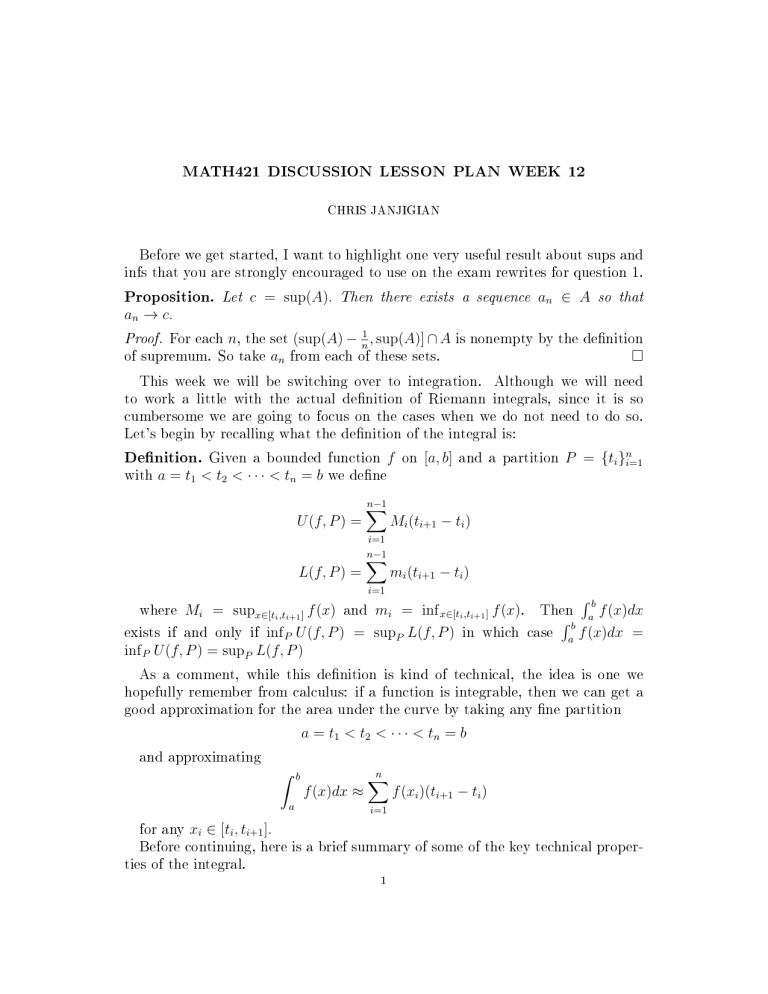
MATH421 DISCUSSION LESSON PLAN WEEK 12
CHRIS JANJIGIAN
Before we get started, I want to highlight one very useful result about sups and
infs that you are strongly encouraged to use on the exam rewrites for question 1.
Proposition.
Let
c = sup(A).
Then there exists a sequence
an ∈ A
so that
an → c.
For each n, the set (sup(A) − n1 , sup(A)] ∩ A is nonempty by the denition
of supremum. So take an from each of these sets.
Proof.
This week we will be switching over to integration. Although we will need
to work a little with the actual denition of Riemann integrals, since it is so
cumbersome we are going to focus on the cases when we do not need to do so.
Let's begin by recalling what the denition of the integral is:
Denition. Given a bounded function f on [a, b] and a partition P = {ti }ni=1
with a = t1 < t2 < · · · < tn = b we dene
U (f, P ) =
n−1
X
Mi (ti+1 − ti )
i=1
L(f, P ) =
n−1
X
mi (ti+1 − ti )
i=1
´
where Mi = supx∈[ti ,ti+1 ] f (x) and mi = inf x∈[ti ,ti+1 ] f (x). Then ab f (x)dx
´
exists if and only if inf P U (f, P ) = supP L(f, P ) in which case ab f (x)dx =
inf P U (f, P ) = supP L(f, P )
As a comment, while this denition is kind of technical, the idea is one we
hopefully remember from calculus: if a function is integrable, then we can get a
good approximation for the area under the curve by taking any ne partition
a = t1 < t2 < · · · < tn = b
and approximating
ˆ
b
f (x)dx ≈
a
n
X
f (xi )(ti+1 − ti )
i=1
for any xi ∈ [ti , ti+1 ].
Before continuing, here is a brief summary of some of the key technical properties of the integral.
1
MATH421 DISCUSSION LESSON PLAN WEEK 12
2
• U (f, P ) ≥ L(f, P )
0
0
0
• If P ⊂ P then U (f, P ) ≤ U (f, P ) and L(f, P ) ≥ L(f, P )
• A function f is integrable if and only if for every > 0 there is a partition
P such that U (f, P ) − L(f, P ) < • Given two partitions P1 and P2 there is a partition P containing P1 and
P2 .
Example. Suppose that f and g are integrable on [a, b]. Show that f + g is
integrable on [a, b].
Fix > 0. We know that there is a partition P1 so that U (f, P1 )−L(f, P1 ) <
and a partition P2 so that U (g, P2 ) − L(g, P2 ) < 2 . Let P be a partition containing P1 and P2 . Notice that
Proof.
2
U (f + g, P ) =
n
X
Mif +g (ti+1 − ti )
i=1
where
Mif
Mif +g
Mig .
= supx∈[ti ,ti+1 ] (f (x)+g(x)) ≤ supx∈[ti ,ti+1 ] f (x)+supx∈[ti ,ti+1 ] g(x) =
Similarly
+
L(f + g, P ) =
n
X
mfi +g (ti+1 − ti )
i=1
where
mfi
+
mgi
mfi +g
= inf x∈[ti ,ti+1 ] (f (x) + g(x)) ≥ inf x∈[ti ,ti+1 ] f (x) + inf x∈[ti ,ti+1 ] g(x) =
. It follows then that
U (f + g, P ) ≤ U (f, P ) + U (g, P )
L(f + g, P ) ≥ L(f, P ) + L(g, P )
and therefore
U (f + g, P ) − L(f + g, P ) ≤ U (f, P ) + U (g, P ) − L(f, P ) − L(g, P )
since
U (f, P ) − L(f, P ) ≤ U (f, P1 ) − L(f, P1 ) <
2
U (g, P ) − L(g, P ) ≤ U (f, P2 ) − L(f, P2 ) <
2
and
we have U (f + g, P ) − L(f + g, P ) < and we are done.
Problem. Find functions f and g on [0, 1] so that neither f nor g is integrable,
but f + g is.
(
1 x∈Q
Proof. We showed in class that f (x) =
is not integrable, but notice
0 x∈
/Q
that if g(x) = −f (x) then f (x) + g(x) = 0, which is integrable, but neither f nor
g is integrable.
MATH421 DISCUSSION LESSON PLAN WEEK 12
3
For the next exercise, we are going to be using one of the most common proof
techniques in analysis, so it's worth taking a moment to highlight it. If you are
trying to prove that two numbers x and y are equal, it is almost always easier to
show that |x − y| < for all > 0 than it is to directly prove x = y.
Example. Show that if f is integrable on [a, b] then for c ∈ (a, b)
´b
c
´b
a
f.
f =
´c
a
f+
Fix > 0 and take a partition P of [a, b] including c with U (f, P ) −
0
00
L(f, P ) < 3 .Call P the restriction of P to [a, c] and P the restriction of P to
0
0
[c, b]. Notice that in particular, this implies that U (f, P ) − L(f, P ) < 3 and
00
similarly for P . Then f is integrable on [a, c] and [c, b]. It follows then that
ˆ b
ˆ c
ˆ b
f−
f−
f| =
|
Proof.
ˆ
a
a
b
c
0
00
ˆ
a
ˆ b
|
ˆ
c
f − U (f, P )| + |
0
ˆ
f − U (f, P )| + |
a
a
b
f| ≤
f−
f − U (f, P ) + U (f, P ) + U (f, P ) −
|
ˆ
c
c
a
b
00
f − U (f, P )|
c
< + + =
3 3 3
Example. Suppose that
f (x) is integrable on [a, b]. Show that |f (x)| is also in´b
´b
tegrable on [a, b] and |
a
f (x)dx| ≤
a
|f (x)|dx.
Fix a partition P with U (f, P ) − L(f, P ) < and frst, recall the triangle
inequality:
Proof.
||f (x)| − |f (y)|| ≤ |f (x) − f (y)|
So if we restrict to a single interval [ti , ti+1 ] we nd that uniformly over x, y ∈
[ti , ti+1 ] we have
||f (x)| − |f (y)|| ≤ |f (x) − f (y)| ≤ Mif − mfi
and therefore
|f |
|f |
Mi − mi ≤ Mif − mfi
We have implicitly used the result here that there is a sequencexn ∈ [ti , ti+1 ] so
that |f (xn )| → Mi|f | and similarly for m|fi | . It then follows that
U (|f |, P ) − L(|f |, P ) ≤ U (f, P ) − L(f, P ) < so that |f | is integrable.
´
´
Observe that since |f (x)| = | − f (x)| if we show ab f (x)dx ≤ ab |f (x)|dx we
are done. But notice that for any partition P we have f (x) ≤ |f (x)| so Mif =
MATH421 DISCUSSION LESSON PLAN WEEK 12
4
supx∈[ti ,ti+1 ] f (x) ≤ supx∈[ti ,ti+1 ] |f (x)| = Mi and therefore U (f, P ) ≤ U (|f |, P )
so
ˆ b
ˆ b
f (x)dx = inf U (f, P ) ≤ inf U (|f |, P ) =
|f (x)|dx
|f |
P
a
P
a
Problem. Suppose
that f´ and g are integrable on [a, b] and f (x) ≤ g(x) for all
´
x. show that
Proof.
b
a
f (x)dx ≤
b
a
g(x)dx
Take any partition P. Then we have
U (f, P ) =
X
Mif (ti+1 − ti ) ≤
X
Mig (ti+1 − ti ) = U (g, P )
It follows then that
ˆ
ˆ
b
f (x)dx = inf U (f, P ) ≤ inf U (g, P ) =
a
P
P
b
g(x)dx
a

